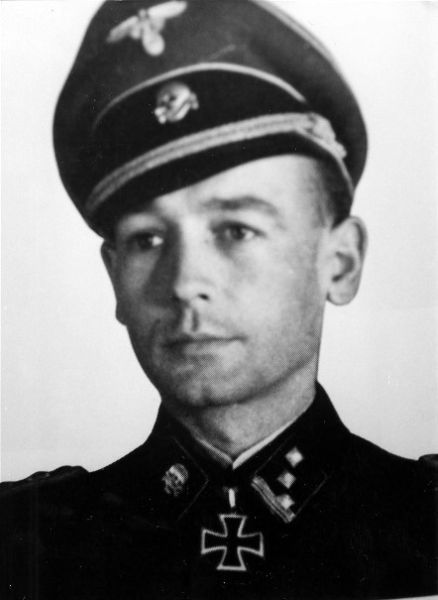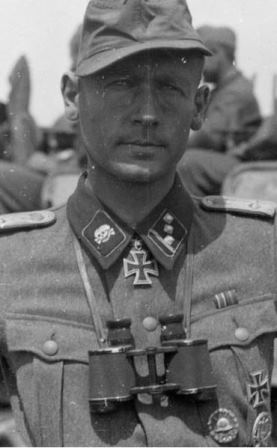Gerth, Walter (SS-Artillerie-Reg. 3 "Totenkopf")
- Date of birth:
- December 14th, 1914 (Kassel/Hessen, Germany)
- Date of death:
- January 10th, 1995 (Kassel/Hessen, Germany)
- Service number:
- SS-Nr.: 372.351 // NSDAP-Nr.:
- Nationality:
- German (1933-1945, Third Reich)
Biography
Walter Gerth finally reached the rank of SS-Sturmbannführer der Reserve.
00.10.1933-00.10.1937: entered the SA
11.09.1934-30.03.1935: RAD
00.09.1935: entered the Wehrmacht - Artillerie-Regiment 27
01.04.1937: entered the SS
00.09.1937: retired as Wachtmeister der Reserve und Reserve-Offizier-Anwärter
01.09.1937: entered the NSDAP
01.09.1939: Zugführer, Maschinengewehr-Kompanie, SS-Heimwehr „Danzig" - SS-Verfügungstruppe
Campaign in Poland - Western Campaign
09.11.1940: promoted to SS-Untersturmführer der Reserve
09.11.1940-23.01.1941: SS-Ustuf, III./ SS-Totenkopf-Infanterie-Ersatz-Bataillon
23.01.1941-07.11.1941: SS-Artillerie-Ersatz-Regiment
07.11.1941-20.08.1943: SS-Artillerie-Regiment 3 / 3. SS-Totenkopf-Division
20.04.1942: promoted to SS-Obersturmführer der Reserve RDA 20.04.1941
20.08.1943-20.10.1944: Chef, 7. Batterie, SS-Artillerie-Regiment 3 / 3. SS-Panzergrenadier-Division 'Totenkopf'
09.11.1943: promoted to SS-Hauptsturmführer der Reserve
11.08.1944: severely WIA for the 6th times with SS-Division „Totenkopf"
20.10.1944-01.02.1945: SS-Artillerie-Ausbildungs- und Ersatz-Regiment - Prag / Beneschau
00.01.1945: Kdr., SS-Artillerie-Lehr-Abteilung / SS-Artillerie-Ausbildungs- und Ersatz-Regiment - SS-Artillerieschule II - Beneschau
01.02.1945: Kdr., III. Abteilung / SS-Artillerie-Ausbildungs-Regiment 1 (renamed)
00.03.1945: promoted to SS-Sturmbannführer der Reserve
25.03.1945: sent to merge his Abteilung within SS-Artillerie-Regiment 38 - 38. SS-Grenadier-Division „Nibelungen" and directed by railroad towards Freiburg i. Breisgau then towards Grafenwöhr then towards Passau due to US troops advance in Germany.
After an air raid the remnants of the Abteilung was disembarked near Plattling and fought against the US region Arnstorf when the war ended.
Do you have more information about this person? Inform us!
- Period:
- Second World War (1939-1945)
- Period:
- Second World War (1939-1945)
- Period:
- Second World War (1939-1945)
- Rank:
- SS-Oberscharführer der Reserve (Staff Sergeant of Reserves)
- Awarded on:
- June 5th, 1940
- Period:
- Second World War (1939-1945)
- Period:
- Second World War (1939-1945)
- Rank:
- SS-Obersturmführer der Reserve (1st Lieutenant of Reserves)
- Unit:
- SS-Artillerie-Regiment 3, 3. SS-Totenkopf-Division
- Awarded on:
- June 17th, 1942
- Period:
- Second World War (1939-1945)
- Rank:
- SS-Untersturmführer der Reserve (2nd Lieutenant of Reserves)
- Unit:
- SS-Artillerie-Regiment 3, 3. SS-Totenkopf-Division
- Awarded on:
- March 14th, 1942
- Period:
- Second World War (1939-1945)
- Rank:
- SS-Obersturmführer der Reserve (1st Lieutenant of Reserves)
- Unit:
- SS-Artillerie-Regiment 3, 3. SS-Totenkopf-Division
- Awarded on:
- July 12th, 1942
- Period:
- Second World War (1939-1945)
- Period:
- Second World War (1939-1945)
- Rank:
- SS-Obersturmführer der Reserve (1st Lieutenant of Reserves)
- Unit:
- Chef, 7. Batterie, SS-Artillerie-Regiment 3 "Totenkopf", SS-Panzer-Division “Totenkopf”, Heeresdetachement “Kempf”, Heeresgruppe Süd
- Awarded on:
- March 31st, 1943
“On the afternoon of the 02.03.1943 the 7. Batterie went into position at the crossroads 4 km south of Loswaja. From here it had the mission of supporting the attack of Pz.Gren.Rgt. 3.
The enemy, which that very afternoon offered extremely tough resistance against the attack of Pz.Gren.Rgt. 1 against Schljachowaja, realized that they were going to be cut off. Over the course of the night they tried to break out in an easterly direction. Thus, in the early morning hours of the 03.03.1943, they crashed against the position of 7. Batterie.
Aided by heavy snowstorms, the enemy succeeded in overrunning the security screen of the Batterie with strong tank/infantry forces and thrusting up to the firing position itself. Here SS-Obersturmführer Gerth, commander of 7. Batterie, threw the enemy back with his Batterie in a bitter engagement fought partially in close combat. The subsequent enemy attacks by superior forces were likewise bloodily fought off.
SS-Obersturmführer Gerth (who utilized opportunities to change positions during the pauses following attacks several times) made the independent decision to block the enemy’s path to the east with his Batterie.
All uninterrupted enemy attacks were repulsed by the Batterie with extremely bloody losses. The Batterie’s efforts meant that the attack of Pz.Gren.Rgt. 1 (launched in the afternoon of the 03.03.1943) succeeded in destroying the bulk of the enemy.
SS-Obersturmführer Gerth therefore managed to prevent the breakout of the enemy to the East through his own independent initiative, leadership and ruthless devotion to duty. Because of this he had a major share in the destruction of the encircled enemy elements.
During this battle the Batterie destroyed the following:
7 T-34s
5 Guns
Numerous trucks and horse-drawn wagons
Numerous light and heavy infantry weapons
Several hundred dead Russians
I ask that SS-Obersturmführer Gerth be awarded the Knight’s Cross in recognition of his decisive action.”
- Period:
- Second World War (1939-1945)
- Rank:
- SS-Hauptsturmführer der Reserve (Captain of Reserves)
- Awarded on:
- August 1944
Sources
- Photo 1: Willi Schumacher Collection
- Photo 2:
- - FELLGIEBEL, W.P., Elite of theThird Reich, Helion & Company Limited, Solihull, 2003.
- MOONEY, PETER, Waffen-SS Knights and their Battles, Schiffer Publishing, Ltd, 2010.
- SCHNEIDER, J.W., Their Honor Was Loyalty!, Bender (R.James) Publishing, 1993.
- Microfilm Publication A3343. US National Archives.














